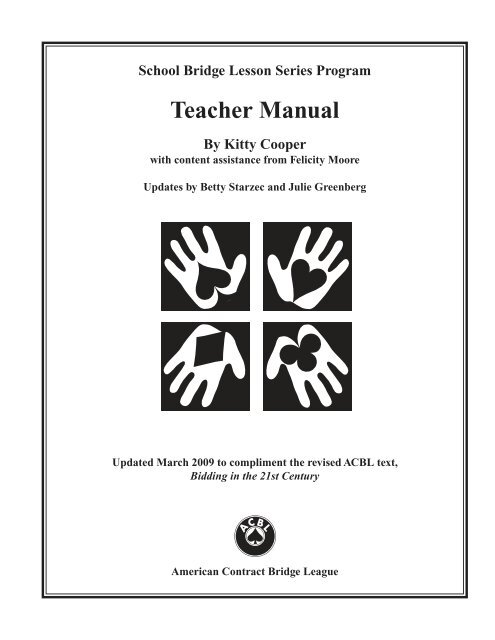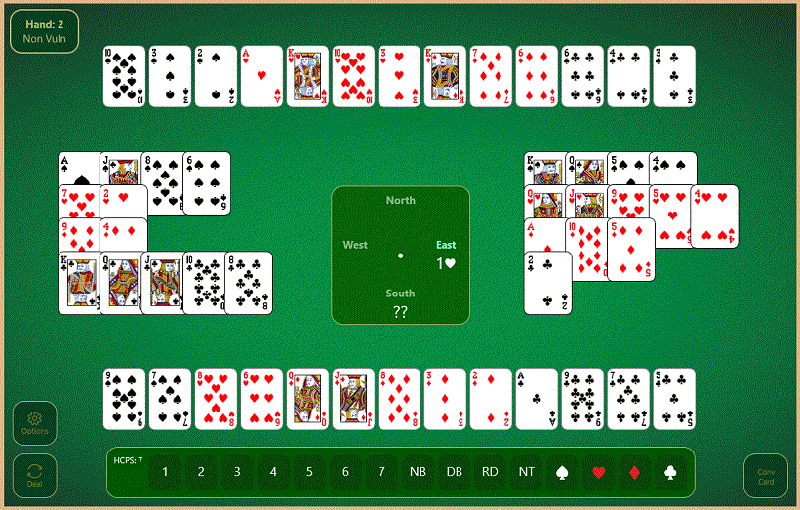Contract Bridge
Learning to play Contract Bridge also involves learning a new language to communicate with your Partner during the auction period of the game. There are a variety of languages (bidding.
- The bridge games
- How to play contract bridge
- The development of the game
- Duplicate and tournament bridge
- Strategy of contract bridge
- Slam bidding
- Bridge problems
- Contract bridge, or simply bridge, is a trick-taking game using a standard 52-card deck. It is played by four players in two competing partnerships, with partners sitting opposite each other around a table. Millions of people play bridge worldwide in clubs, tournaments, online and with friends at ho.
- Play Contract Bridge Online - Against The Computer Playing Bridge online against the computer is where most people start with BridgeDoctor - when you play Bridge against the computer you can practise at your own pace. Once you have logged in, from the main page on Bridge Doctor, click on the PLAY link then select 'Play against the computer'.
- Frank Stewart has been involved with bridge as a journalist, author, editor, competitor, and teacher. He is the creator of the popular “Daily Bridge Club” column.

Our editors will review what you’ve submitted and determine whether to revise the article.
Join Britannica's Publishing Partner Program and our community of experts to gain a global audience for your work! Albert H. MoreheadSee All Contributors

Bridge, card game derived from whist, through the earlier variants bridge whist and auction bridge. The essential features of all bridge games, as of whist, are that four persons play, two against two as partners; a standard 52-card deck of playing cards is dealt out one at a time, clockwise around the table, so that each player holds 13 cards; and the object of play is to win tricks, each trick consisting of one card played by each player. Another feature is that one suit may be designated the trump suit (i.e., any card in that suit may take any card of the other suits), but the methods of designating the trump suit (or of determining that a deal will be played without trumps) differ in the various bridge games, as explained below.
Since about 1896 bridge whist, auction bridge, and contract bridge have successively been the principal intellectual card games of the English-speaking countries. The third game of the series, contract bridge, spread throughout the world and in some respects constituted a social phenomenon unparalleled in the history of games. In addition to millions of casual players worldwide, there exist numerous national federations affiliated with the World Bridge Federation (WBF), which organizes international tournaments for more-serious competitors. Its largest affiliated member is the American Contract Bridge League (ACBL) with nearly 160,000 members.
The arrival of personal computers and the Internet opened up new opportunities for instruction and play. In addition to being a venue for casual play, some Internet sites host tournaments recognized by ACBL and WBF at which participants can earn international master points.
The bridge games
The first game of the series was originally called, simply, bridge, but it is now called bridge whist to distinguish it from the two later games. Upon its introduction to New York in 1893 and to London in 1894, it almost immediately supplanted whist in the card rooms of men’s clubs, and before 1900 it was the favourite diversion of fashionable mixed gatherings. Bridge whist was itself supplanted with almost equal rapidity by auction bridge, which was introduced in England about 1904 and which became, from 1907 to 1928, the most universally popular card game theretofore known. Auction bridge had at least 15 million adherents when it was supplanted by contract bridge about 1930 and began to die out.
Bridge whist
In bridge, as in whist, there are four players in two partnerships, each player being dealt 13 cards. But in whist there is always a trump suit, determined by turning up the last card dealt to the dealer, and each player holds and plays his own hand. The principal innovations of bridge whist were: selection of the trump suit by the dealer or the dealer’s partner after they saw their hands; the option of playing at no trump; the exposed dummy (the hand of dealer’s partner), which was played by the dealer; a different method of scoring; and the right to double (the scoring values).
In bridge whist, after the cards were dealt, the dealer could make the declaration (name any suit as trump, or decide to play without any trump), or he could transfer this duty to his partner. Before leading, the player on the dealer’s left (eldest hand) could double or could pass that privilege to his partner; and if either doubled, dealer or his partner could redouble, and so the redoubling might continue indefinitely (except that many clubs placed a limit upon the number of redoubles).
The player on the dealer’s left then led. Dealer’s partner, called the dummy, placed his entire hand faceup on the table in front of him, and dealer played both his own cards and dummy’s, from each hand in proper turn. Otherwise play was as at whist.
The side that won the majority of the tricks scored, for each odd trick (trick over six): if spades were trumps, 2 points; clubs, 4; diamonds, 6; hearts, 8; no trump, 12; these values doubled and redoubled as previously determined. The first side thus to score 30 or more points won game, and a fresh game was begun. The first side to win two games won rubber and received a 100-point bonus. Other bonuses, which did not count toward game, were awarded for a side holding three or more honours (ace, king, queen, jack, and 10) of the trump suit or, at no-trump declarations, three or more aces; for making slams (12 or 13 tricks won); and for chicane (a player’s holding no card of the trump suit).
Auction bridge

The essential features added by auction bridge were that all four players bid for the right to name the trump suit and that the high bidder or his partner (not necessarily the dealer) became declarer and played the dummy’s hand. In other respects the procedure at auction bridge underwent constant and frequent change.

Contract bridge
In its mechanics, contract bridge differs from auction bridge only in the scoring. At auction bridge, declarer’s side scores toward game each odd trick that it wins, whether or not it contracted to win such a trick. At contract bridge, the odd tricks won by declarer cannot be scored toward game unless declarer’s side previously contracted to win those tricks. Values of tricks, penalties, and premiums are higher in contract bridge than in auction bridge, and large bonuses are awarded for bidding and making slam contracts. See belowScoring.
- related topics
Bridge is a fun and challenging game to be enjoyed by players of all ages. 247 Bridge is the perfect game for beginners and experts alike, as there are always ? buttons along the way to help you play the game if you are confused, or you can turn these off to play the expert game of bridge you know and love!
Bridge is played with one full set of cards. Four players are required for bridge (lucky for you, we've created amazing artificial intelligence so you can play any time at your computer!). Bridge is a game of partnerships, so the player across the table is your partner, and the players to the right and left are on the opposing team.
Bridge is made up of two main parts. Initially the bidding process and then the game play. Suits are ranked in Bridge from Spades, Hearts, Diamonds, to Clubs, the lowest. This is important in the bidding process and scoring. During the bidding process, players are determining how many tricks they can take with a single suit (or no suit - NT) as Trump. Trump means a card of that suit will always win the trick (if it is the highest of that trump suit played within that trick). If you bid, it is assumed your team will win 6 + the number of tricks bid. So, if you bid 1 Spade, you are saying you think your team can win 7 tricks during the hand with Spades as the trump suit. Obviously you don't know what your teammate has so there is a bit of back and forth and guessing involved, but that's where the fun is! If you don't think you can up your teammate or opponent's bid, just pass. Three passes in a row means a bid is complete and the computer will tell you who wins the bid and with what bid. Doubling is a way to let your opponent know you don't think they can win the amount of the bid they have set during the bidding process. You are upping the ante by doubling the points. A Redouble is used when an opponent doubles your partner and you Redouble, stating you definitely can win that hand with those tricks. A double or redouble is wiped from the board whenever another bid is made after it. There are many complicated ways to determine how to bid which we will not go into here, but you are welcome to research as the internet has a plethora of sites to learn from.
Contract Bridge Programs For Windows
The game play portion of Bridge is where the hand is played out. One hand will always be flipped so you can see the cards. If your team won the bid, you will be playing your teammate's hand. Otherwise, you will see one of your opponent's hands. If your team has won the bid, the goal is to take that many tricks by playing high cards or trump cards. If your team did not win the bid, your goal is to stop the other team from meeting their bid by winning your own tricks. Once the hand is completed either the bidding team will have won or lost and the points will be tallied up accordingly. Only the winning bid team will be allowed to make points towards their game score if they succeed in meeting or exceeding their bet. All other points are tallied in the bonus section of the board. A game is won when a team reaches 100 game points. The bridge match is best two out of three. At the point where a team wins two of the games, all the scores, including the game and bonus scores, are added up to determine the winner.
- The player across the table is your teammate. Try to play off their bids to get the most number of points!
- Try a counting strategy when bidding. A=4,K=3,Q=2,J=1,Empty Suits=3,1 card suits=2, and 2 card suits=1.
- If you have less than 13 points, don't bid! Always pass!
- With a balanced hand and 16-18 points, feel free to bid 1 No Trump.
- If your hand is not eligible for this 1 NT bid, and you have 13 or more points, open a bid with your strongest suit.
Contract Bridge Bidding Cheat Sheet
DISCLAIMER: The games on this website are using PLAY (fake) money. No payouts will be awarded, there are no 'winnings', as all games represented by 247 Games LLC are free to play. Play strictly for fun.



